Detrital-Zircon Geochronology of Jurassic–Cretaceous Strata in the Turpan-Hami Basin: Implication for the Late Mesozoic Tectonic Evolution of Eastern Tien Shan
Abstract
:1. Introduction
2. Geological Setting
2.1. Regional Geological Setting and Potential Sources
2.2. The Turpan-Hami Basin
3. Datasets and Analytical Methods
3.1. Datasets
3.2. Analytical Methods
4. Results
4.1. Zircon Morphology, Origin, and U-Pb Ages
4.2. Statistical Comparisons
4.2.1. Early Jurassic
4.2.2. Middle Jurassic
4.2.3. Late Jurassic
4.2.4. Cretaceous
5. Discussions
5.1. Quantitatively Determined Source Mixing Proportions: Implication for Multi-Stage Evolution of the Eastern Tien Shan Region
5.2. A preliminary Exploration of the Limitations of Inverse Monte Carlo Model Decomposition of Detrital-Zircon Provenance
6. Conclusions
- During the Early Jurassic, Bogda provided few sources, merely as positive topography;
- From the Early Jurassic to the Cretaceous, the source proportion of Bogda gradually increased over time, especially the large-scale uplift and denudation that occurred after the development of the Qigu Formation;
- The proportions of the Jueluotag and central Tien Shan gradually declined as a group, stabilizing before the Cretaceous. Central Tien Shan showed a slightly growing trend (41.3%) from the Early Jurassic to the Middle Jurassic and then gradually decreased to 20.3%, still accounting for a sizeable proportion of sources;
- Similar to central Tien Shan, Jueluotag gradually decreased from an initial 51.8% to 14.9% in the Late Jurassic, but the proportion increased again to 26% in the Cretaceous;
- Central Tien Shan and Jueluotag tended to resurrect during the Cretaceous, somewhat inaugurating the Cenozoic tectonic activity.
Supplementary Materials
Author Contributions
Funding
Institutional Review Board Statement
Informed Consent Statement
Data Availability Statements
Conflicts of Interest
References
- Finch, R.J.; Hanchar, J.M. Structure and Chemistry of Zircon and Zircon-Group Minerals. Rev. Mineral. Geochem. 2003, 53, 1–25. [Google Scholar] [CrossRef]
- Gehrels, G.E. Detrital zircon U-Pb geochronology applied to tectonics. Annu. Rev. Earth Planet. Sci. 2014, 42, 127–149. [Google Scholar] [CrossRef]
- Gehrels, G.E.; Blakey, R.; Karlstrom, K.E.; Timmons, J.M.; Dickinson, B.; Pecha, M. Detrital zircon U-Pb geochronology of Paleozoic strata in the Grand Canyon, Arizona. Lithosphere 2011, 3, 183–200. [Google Scholar] [CrossRef] [Green Version]
- Thomas, W.A. Detrital-zircon geochronology and sedimentary provenance. Lithosphere 2011, 3, 304–308. [Google Scholar] [CrossRef] [Green Version]
- Siégel, C.; Bryan, S.E.; Allen, C.M.; Gust, D.A. Use and abuse of zircon-based thermometers: A critical review and a recommended approach to identify antecrystic zircons-ScienceDirect. Earth-Sci. Rev. 2018, 176, 87–116. [Google Scholar] [CrossRef]
- Vermeesch, P. Multi-sample comparison of detrital age distributions. Chem. Geol. 2013, 341, 140–146. [Google Scholar] [CrossRef]
- Saylor, J.E.; Sundell, K.E. Quantifying comparison of large detrital geochronology data sets. Geosphere 2016, 12, 203–220. [Google Scholar] [CrossRef] [Green Version]
- Sundell, K.E.; Saylor, J.E. Unmixing detrital geochronology age distributions. Geochem. Geophys. Geosystems 2017, 18, 2872–2886. [Google Scholar] [CrossRef]
- Satkoski, A.M.; Wilkinson, B.H.; Hieptas, J.; Samson, S.D. Likeness among detrital zircon populations-An approach to the comparison of age frequency data in time and space. GSA Bull. 2013, 125, 1783–1799. [Google Scholar] [CrossRef]
- Mao, J.W.; Goldfarb, R.J.; Wang, Y.T.; Hart, C.J.; Wang, Z.L.; Yang, J.M. Late Paleozoic base and precious metal deposits, East Tienshan, Xinjiang, China: Characteristics and geodynamic setting. Episodes 2005, 28, 23–36. [Google Scholar] [CrossRef] [Green Version]
- Sengör, A.M.C.; Natal’in, B.A.; Burtman, V.S. Evolution of the Altaid tectonic collage and Paleozoic crustal growth in Eurasia. Nature 1993, 364, 299–307. [Google Scholar] [CrossRef]
- Windley, B.F.; Alexeiev, D.; Xiao, W.J.; Kröner, A.; Badarch, G. Tectonic models for accretion of the Central Asian Orogenic Belt. J. Geol. Soc. 2007, 164, 31–47. [Google Scholar] [CrossRef] [Green Version]
- Xiao, W.J.; Windley, B.F.; Hao, J.; Zhai, M.G. Accretion leading to collision and the Permian Solonker suture, Inner, Mongolia, China: Termination of the Central Asian Orogenic Belt. Tectonics 2003, 22, 1069. [Google Scholar] [CrossRef] [Green Version]
- Xiao, W.J.; Windley, B.F.; Yan, Q.R.; Qin, K.Z.; Chen, H.L.; Yuan, C.; Sun, S. SHRIMP zircon age of the Aermantai ophiolite in the North Xinjiang, China, and its tectonic implications. Acta Geol. Sin. 2006, 80, 32–36, (In Chinese with English abstract). [Google Scholar]
- Xiao, W.J.; Huang, B.C.; Han, C.M.; Sun, S.; Li, J.L. A review of the western part of the Altaids: A key to understanding the architecture of accretionary orogens. Gondwana Res. 2010, 18, 253–273. [Google Scholar] [CrossRef]
- Allen, M.B.; Windley, B.F.; Zhang, C. Palaeozoic collisional tectonics and magmatism of the Chinese Tien Shan, central Asia. Tectonophysics 1993, 220, 89–115. [Google Scholar] [CrossRef]
- Carroll, A.R.; Graham, S.A.; Hendrix, M.S.; Ying, D.; Zhou, D. Late Paleozoic tectonic amalgamation of northwestern China: Sedimentary record of the northern Tarim, northwestern Turpan, and southern Junggar basins. GSA Bull. 1995, 107, 571–594. [Google Scholar] [CrossRef]
- Gao, J.; Long, L.L.; Klemd, R.; Qian, Q.; Liu, D.Y.; Xiong, X.M.; Yang, F.Q. Tectonic evolution of the South Tienshan orogen and adjacent regions, NW China: Geochemical and age constraints of granitoid rocks. Int. J. Earth Sci. 2009, 98, 1221–1238. [Google Scholar] [CrossRef]
- Xiao, W.; Windley, B.F.; Allen, M.B.; Han, C. Paleozoic multiple accretionary and collisional tectonics of the Chinese Tienshan orogenic collage. Gondwana Res. 2013, 23, 1316–1341. [Google Scholar] [CrossRef]
- Charreau, J.; Chen, Y.; Gilder, S.; Dominguez, S.; Avouac, J.P.; Sen, S.; Wang, W.M. Magnetostratigraphy and rock magnetism of the Neogene Kuitun He section (northwest China): Implications for Late Cenozoic uplift of the Tianshan Mountains. Earth Planet. Sci. Lett. 2005, 230, 177–192. [Google Scholar] [CrossRef] [Green Version]
- Charreau, J.; Gilder, S.; Chen, Y.; Dominguez, S.; Avouac, J.P.; Sen, S.; Wang, W.M. Magnetostratigraphy of the Yaha section, Tarim Basin (China): 11 Ma acceleration in erosion and uplift of the Tian Shan mountains. Geology 2006, 34, 181–184. [Google Scholar] [CrossRef] [Green Version]
- Jolivet, M.; Dominguez, S.; Charreau, J.; Chen, Y.; Li, Y.A.; Wang, Q.C. Mesozoic and Cenozoic tectonic history of the Central Chinese Tian Shan: Reactivated tectonic structures and active deformation. Tectonics 2010, 29, TC6019. [Google Scholar] [CrossRef] [Green Version]
- Fang, Y.N.; Wu, C.D.; Guo, Z.J.; Hou, K.J.; Dong, L.; Wang, L.X.; Li, L.L. Provenance of the southern Junggar Basin in the Jurassic: Evidence from detrital zircon geochronology and depositional environments. Sediment. Geol. 2015, 315, 47–63. [Google Scholar] [CrossRef]
- Fang, Y.N.; Wu, C.D.; Wang, Y.Z.; Hou, K.J.; Gao, Z.J. Topographic evolution of the Tienshan Mountains and their relation to the Junggar and Turpan Basins, Central Asia, from the Permian to the Neogene. Gondwana Res. 2019, 75, 47–67. [Google Scholar] [CrossRef]
- Ji, H.J.; Tao, H.; Wang, Q.; Qiu, Z.; Ma, D.; Qiu, J.; Liao, P. Early to Middle Jurassic tectonic evolution of the Bogda Mountains, Northwest China: Evidence from sedimentology and detrital zircon geochronology. J. Asian Earth Sci. 2018, 153, 57–74. [Google Scholar] [CrossRef]
- Ji, H.J.; Tao, H.F.; Qiu, J.L.; Wei, H.Y. Provenance of Middle Jurassic clastic rocks from the Bogda region of Eastern Tienshan and its implications. Int. Geol. Rev. 2019, 6, 1319–1342. [Google Scholar] [CrossRef]
- Zhang, X.R.; Zhao, G.C.; Sun, M.; Han, Y.G.; Liu, Q. Triassic magmatic reactivation in Eastern Tienshan, NW China: Evidence from geochemistry and zircon U-Pb-Hf isotopes of granites. J. Asian Earth Sci. 2017, 145, 446–459. [Google Scholar] [CrossRef]
- Yang, Y.T.; Song, C.C.; He, S. Jurassic tectonostratigraphic evolution of the Junggar basin, NW China: A record of Mesozoic intraplate deformation in Central Asia. Tectonics 2015, 34, 86–115. [Google Scholar] [CrossRef]
- Graham, S.A.; Hendrix, M.S.; Wang, L.B.; Carroll, A.R. Collisional successor basins of western China: Impact of tectonic inheritance on sand composition. GSA Bull. 1993, 105, 323–344. [Google Scholar] [CrossRef]
- Greene, T.J.; Carroll, A.R.; Hendix, M.S.; Graham, S.A.; Wartes, M.A.; Abbink, O.A. Sedimentary record of Mesozoic deformation and inception of the Turpan-Hami basin, north-west China. GSA Bull. 2001, 194, 317–340. [Google Scholar] [CrossRef] [Green Version]
- Guan, Y.Z.; Liu, C.Y.; Zhang, S.H.; Wang, J.Q.; Liang, H. The characteristics of the heavy mineral assemblages of the Middle Jurassic in the north central Tuha Basin and their constraints on the uplift of Bogda Mountain. Chin. J. Geol. 2018, 53, 1389–1404, (In Chinese with English abstract). [Google Scholar]
- Hendrix, M.S.; Graham, S.A.; Carroll, A.R.; Sobel, E.R.; McKnight, C.L.; Schulein, B.J.; Wang, Z. Sedimentary record and climatic implications of recurrent deformation in the Tien Shan: Evidence from Mesozoic strata of the north Tarim, south Junggar, and Turpan basins, northwest China. GSA Bull. 1992, 104, 53–79. [Google Scholar] [CrossRef]
- Ji, H.J.; Tao, H.F.; Wang, Q.; Ma, D.X.; Hao, L.W. Petrography, geochemistry, and geochronology of Lower Jurassic sedimentary rocks from the Northern Tienshan (West Bogda region), Northwest China: Implications for provenance and tectonic evolution. Geol. J. 2018, 54, 1688–1714. [Google Scholar] [CrossRef]
- Shao, L.Y.; Zhang, P.F.; Hilton, J.; Gayer, R.; Wang, Y.B.; Zhao, C.Y.; Luo, Z. Paleoenvironments and paleogeography of the Lower and lower Middle Jurassic coal measures in the Turpan-Hami oil-prone coal basin, northwestern China. AAPG Bull. 2003, 87, 335–355. [Google Scholar] [CrossRef]
- Tang, W.H.; Zhang, Z.C.; Li, J.F.; Li, K. Late Paleozoic to Jurassic tectonic evolution of the Bogda region (northwest China): Evidence from detrital zircon U-Pb geochronology. Tectonophysics 2014, 626, 144–156. [Google Scholar] [CrossRef]
- Zhao, R.; Zhang, J.Y.; Zhou, C.M.; Zhang, Z.J.; Chen, S.; Stockli, D.F.; Wang, H. Tectonic evolution of Tienshan-Bogda-Kelameili mountains, clastic wedge basin infill and chronostratigraphic divisions in the source-to-sink systems of Permian-Jurassic, southern Junggar Basin. Mar. Petrol. Geol. 2020, 114, 104–200. [Google Scholar] [CrossRef]
- Shen, C.B.; Mei, L.F.; Liu, L.; Tang, J.G.; Zhou, F. Evidence from apatite and zircon fission track analysis for Mesozoic-Cenozoic uplift thermal history of Bogda Mountain of Xinjiang, Northwest China. Mar. Geol. Quatern. Geol. 2006, 26, 87–92, (In Chinese with English abstract). [Google Scholar]
- Zhou, T.Q.; Wu, C.D.; Yuan, B.; Shi, Z.K.; Wang, J.L.; Zhu, W.; Ma, J. Characteristics of Jurassic heavy minerals in the southern margin of Junggar Basin and their provenance indicating significance. Pet. Explor. Dev. 2019, 46, 65–78, (In Chinese with English abstract). [Google Scholar] [CrossRef]
- Chen, K.; Lin, W.; Wang, Q.C. The Bogeda Shan uplifting: Evidence from multiple phases of deformation. Asian Earth Sci. 2015, 99, 1–12. [Google Scholar] [CrossRef]
- Fang, S.H.; Guo, Z.J.; Song, Y.; Wu, C.D.; Zhang, Z.C.; Wang, M.N.; Fan, R.D. Sedimentary facies evolution and basin pattern of the Jurassic in southern margin region of Junggar Basin. J. Palaeogeogr. 2005, 7, 347–356, (In Chinese with English abstract). [Google Scholar]
- Li, W.; Hu, J.M.; Li, D.P.; Liu, J.X.; Sun, Y.P.; Liang, J.W. Analysis of the Late Paleozoic and Mesozoic paleocurrents and it’s constructional significance of the northern Bogdashan, Xinjiang. Acta Sediment. Sin. 2007, 25, 283–292, (In Chinese with English abstract). [Google Scholar]
- Shao, L.; Stattegger, K.; Li, W.H.; Haupt, B.J. Depositional style and subsidence history of the Turpan Basin (NW China). Sediment. Geol. 1999, 128, 155–169. [Google Scholar] [CrossRef]
- Shen, T.Y.; Chen, Y.; Wang, G.C.; Ji, J.L.; Wang, Y.; Zhang, P.; Xu, Z.Z. Detrital zircon geochronology analysis of the Late Mesozoic deposition in the Turpan-Hami basin: Implications for the uplift history of the Eastern Tien Shan, northwestern China. Terra Nova 2019, 32, 166–178. [Google Scholar] [CrossRef]
- Zhang, C.H.; Zhang, D.B.; Liu, C.L.; Zhang, Z.Q.; Wang, Q.X.; Yu, Q.X. Stratigraphic constraints on the initial uplift age of Bogda Shan, Xinjiang, northwest China. Earth Sci. Front. 2005, 12, 294–302, (In Chinese with English abstract). [Google Scholar]
- Xiao, W.J.; Sun, M.; Santosh, M. Continental reconstruction and metallogeny of the Circum-Junggar regions and termination of the southern Central Asian Orogenic Belt. Geosci. Front. 2015, 6, 137–140. [Google Scholar] [CrossRef] [Green Version]
- Yakubchuk, A. Architecture and mineral deposit settings of the Altaid orogenic collage: A revised model. J. Asian Earth Sci. 2004, 23, 761–779. [Google Scholar] [CrossRef]
- Buslov, M.M.; Watanabe, T.; Fujiwara, Y.; Iwata, K.; Smirnova, L.V.; Safonova, I.Y.; Kiryanova, A.P. Late Paleozoic faults of the Altai region, Central Asia: Tectonic pattern and model of formation. J. Asian Earth Sci. 2004, 23, 655–671. [Google Scholar] [CrossRef]
- Coleman, R.G. Continental growth of northwest China. Tectonics 1989, 8, 621–635. [Google Scholar] [CrossRef]
- Han, B.F.; He, G.Q.; Wang, X.C.; Guo, Z.J. Late Carboniferous collision between the Tarim and Kazakhstan-Yili terranes in the western segment of the South Tien Shan Orogen, Central Asia, and implications for the Northern Xinjiang, western China. Earth-Sci. Rev. 2011, 109, 74–93. [Google Scholar] [CrossRef]
- Huang, H.; Zhang, Z.C.; Santosh, M.; Zhang, D.Y.; Wang, T. Petrogenesis of the Early Permian volcanic rocks in the Chinese South Tienshan: Implications for crustal growth in the Central Asian Orogenic Belt. Lithos 2015, 228-229, 23–42. [Google Scholar] [CrossRef]
- Kröner, A.; Kovach, V.; Belousova, E.; Hegner, E.; Armstrong, R.; Dolgopolova, A.; Rytsk, E. Reassessment of continental growth during the accretionary history of the Central Asian Orogenic Belt. Gondwana Res. 2014, 25, 103–125. [Google Scholar] [CrossRef]
- Xiao, W.J.; Windley, B.F.; Huang, B.C.; Han, C.M.; Yuan, C.; Chen, H.L.; Li, J.L. End-Permian to mid-Triassic termination of the accretionary processes of the southern Altaids: Implications for the geodynamic evolution, Phanerozoic continental growth, and metallogeny of Central Asia. Int. J. Earth Sci. 2009, 98, 1189–1217. [Google Scholar] [CrossRef]
- Xiao, W.J.; Windley, B.F.; Yuan, C.; Sun, M.; Han, C.M.; Lin, S.F.; Sun, S. Paleozoic multiple subduction-accretion processes of the southern Altaids. Am. J. Sci. 2009, 309, 221–270. [Google Scholar] [CrossRef]
- Xiao, W.J.; Zhang, L.C.; Qin, K.Z.; Sun, S.; Li, J.L. Paleozoic accretionary and collisional tectonics of the Eastern Tienshan (China): Implications for the continental growth of central Asia. Am. J. Sci. 2004, 304, 370–395. [Google Scholar] [CrossRef] [Green Version]
- Jolivet, M.; Bourquin, S.; Heilbronn, G.; Robin, C.; Barrier, L.; Dabard, M.P.; Fu, B. The Upper Jurassic-Lower Cretaceous alluvial fan deposits of the Kalaza Formation (Central Asia): Tectonic pulse or increased aridity? GSA Bull. 2016, 427, 491–521. [Google Scholar] [CrossRef]
- Avouac, J.P.; Tapponnier, P.; Bai, M.; You, H.; Wang, G. Active thrusting and folding along the northern Tien Shan and late Cenozoic rotation of the Tarim relative to Dzungaria and Kazakhstan. J. Geophys. Res. Solid Earth 1993, 98, 6755–6804. [Google Scholar] [CrossRef] [Green Version]
- Hendrix, M.S.; Dumitru, T.A.; Graham, S.A. Late Oligocene-early Miocene unroofing in the Chinese Tian Shan: An early effect of the India-Asia collision. Geology 1994, 22, 487–490. [Google Scholar] [CrossRef]
- Yang, W.; Jolivet, M.; Dupont-Nivet, G.; Guo, Z.J. Mesozoic-Cenozoic tectonic evolution of southwestern Tian Shan: Evidence from detrital zircon U/Pb and apatite fission track ages of the Ulugqat area, Northwest China. Gondwana Res. 2014, 26, 986–1008. [Google Scholar] [CrossRef]
- Han, Y.G.; Zhao, G.C. Final amalgamation of the Tienshan and Junggar orogenic collage in the southwestern Central Asian Orogenic Belt: Constraints on the closure of the Paleo-Asian Ocean. Earth Sci. Rev. 2018, 186, 129–152. [Google Scholar] [CrossRef]
- Xia, L.Q.; Xu, X.Y.; Xia, Z.C.; Li, X.M.; Ma, Z.P.; Wang, L.S. Petrogenesis of Carboniferous rift-related volcanic rocks in the Tienshan, northwestern China. GSA Bull. 2004, 116, 419–433. [Google Scholar] [CrossRef]
- Xia, L.Q.; Xia, Z.C.; Xu, X.Y.; Li, X.M.; Ma, Z.P. Relative contributions of crust and mantle to the generation of the Tienshan Carboniferous rift-related basic lavas, northwestern China. J. Asian Earth Sci. 2008, 31, 357–378. [Google Scholar] [CrossRef]
- Xie, W.; Xu, Y.G.; Luo, Z.Y.; Liu, H.Q.; Hong, L.B.; Ma, L. Petrogenesis and geodynamic implications of the Late Carboniferous1 felsic volcanics in the Bogda belt, Chinese Northern Tienshan. Gondwana Res. 2016, 39, 165–179. [Google Scholar] [CrossRef]
- Yang, W.; Jolivet, M.; Dupont-Nivet, G.; Guo, Z.J.; Zhang, Z.C.; Wu, C.D. Source to sink relations between the Tien Shan and Junggar Basin (northwest China) from Late Palaeozoic to Quaternary: Evidence from detrital U-Pb zircon geochronology. Basin Res. 2013, 25, 219–240. [Google Scholar] [CrossRef]
- Wali, G.; Wang, B.; Cluzel, D.; Zhong, L. Carboniferous-Early Permian magmatic evolution of the Bogda Range (Xinjiang, NW China): Implications for the Late Paleozoic accretionary tectonics of the SW Central Asian Orogenic Belt. J. Asian Earth Sci. 2018, 153, 238–251. [Google Scholar] [CrossRef]
- Zhang, X.R.; Zhao, G.C.; Sun, M.; Eizenhöfer, P.R.; Han, Y.G.; Hou, W.Z.; Xu, B. Tectonic evolution from subduction to arc-continent collision of the Junggar ocean: Constraints from U-Pb dating and Hf isotopes of detrital zircons from the North Tien shan belt, NW China. GSA Bull. 2017, 128, 644–660. [Google Scholar] [CrossRef]
- Zhao, L.D.; Chen, H.Y.; Zhang, L.; Zhang, W.F.; Yang, J.T.; Yan, X. The Late Paleozoic magmatic evolution of the Aqishan-Yamansu belt, Eastern Tienshan: Constraints from geochronology, geochemistry and Sr-Nd-Pb-Hf isotopes of igneous rocks. J. Asian Earth Sci. 2018, 153, 170–192. [Google Scholar] [CrossRef]
- Shu, L.S.; Charvet, J.; Guo, L.Z.; Lu, H.F.; Laurent-Charvet, S. A large-scale Palaeozoic dextral ductile strike-slip zone: The Aqqikkudug-Weiya zone along the northern margin of the Central Tienshan Belt, Xinjiang, NW China. Acta Geo. Sin. 1999, 73, 148–162. [Google Scholar] [CrossRef]
- Wang, B.; Cluzel, D.; Jahn, B.M.; Shu, L.; Chen, Y.; Zhai, Y.; Sizaret, S. Late Paleozoic pre-and syn-kinematic plutons of the Kangguer-Huangshan shear zone: Inference on the tectonic evolution of the eastern Chinese north Tienshan. Am. J. Sci. 2014, 314, 43–79. [Google Scholar] [CrossRef]
- Liu, H.Q.; Xu, Y.G.; Wei, G.J.; Wei, J.X.; Yang, F.; Chen, X.Y.; Wei, X. B isotopes of Carboniferous-Permian volcanic rocks in the Tuha basin mirror a transition from subduction to intraplate setting in Central Asian Orogenic Belt. J. Geophys. Res. Sol. Ea. 2016, 121, 7946–7964. [Google Scholar] [CrossRef]
- Ma, X.H.; Chen, B.; Wang, C.; Yan, X.L. Early Paleozoic subduction of the Paleo-Asian Ocean: Zircon U-Pb geochronological, geochemical and Sr-Nd isotopic evidence from the Harlik pluton, Xinjiang. Acta Petrol. Sin. 2015, 31, 89–104, (In Chinese with English abstract). [Google Scholar]
- Yuan, C.; Sun, M.; Wilde, S.; Xiao, W.J.; Xu, Y.G.; Long, X.P.; Zhao, G.C. Post-collisional plutons in the Balikun region, East Chinese Tienshan: Evolving magmatism in response to extension and slab break-off. Lithos 2010, 119, 269–288. [Google Scholar] [CrossRef]
- Ma, J. Study on the Huangcaopo Group in the Eastern Junggar. J. Mineral. Petrol. 1999, 19, 5–55, (In Chinese with English abstract). [Google Scholar]
- Chen, X.J.; Shu, L.S.; Santosh, M.; Zhao, X.X. Island arc-type bimodal magmatism in the eastern Tienshan Belt, Northwest China: Geochemistry, zircon U-Pb geochronology and implications for the Paleozoic crustal evolution in Central Asia. Lithos 2013, 168-169, 48–66. [Google Scholar] [CrossRef]
- Huang, B.; Fu, D.; Kusky, T.; Ruan, K.P.; Zhou, W.X.; Zhang, X.H. Sedimentary provenance in response to Carboniferous arc-basin evolution of East Junggar and North Tienshan belts in the southwestern Central Asian Orogenic Belt. Tectonophysics 2018, 722, 324–341. [Google Scholar] [CrossRef]
- Hu, A.; Jahn, B.M.; Zhang, G.; Chen, Y.; Zhang, Q. Crustal evolution and Phanerozoic crustal growth in northern Xinjiang: Nd isotopic evidence. Part I. Isotopic characterization of basement rocks. Tectonophysics 2000, 328, 15–51. [Google Scholar] [CrossRef]
- Huang, Z.; Long, X.; Kröner, A.; Yuan, C.; Wang, Y.; Chen, B.; Zhang, Y. Neoproterozoic granitic gneisses in the Chinese Central Tienshan Block: Implications for tectonic affinity and Precambrian crustal evolution. Precambrian Res. 2015, 269, 73–89. [Google Scholar] [CrossRef]
- Wang, X.S.; Gao, J.; Klemd, R.; Jiang, T.; Li, J.L.; Zhang, X.; Xue, S.C. The Central Tienshan Block: A microcontinent with a Neoarchean-Paleoproterozoic basement in the southwestern Central Asian Orogenic Belt. Precambrian Res. 2017, 295, 130–150. [Google Scholar] [CrossRef]
- Ma, X.; Shu, L.; Meert, J.G.; Li, J. The Paleozoic evolution of Central Tienshan: Geochemical and geochronological evidence. Gondwana Res. 2014, 25, 797–819. [Google Scholar] [CrossRef]
- Gao, J.; Klemd, R. Formation of HP-LT rocks and their tectonic implications in the western Tienshan Orogen, NW China: Geochemical and age constraints. Lithos 2003, 66, 1–22. [Google Scholar] [CrossRef]
- Allen, M.B.; Şengör, A.M.C.; Natalin, B.A. Junggar, Turfan and Alakol basins as Late Permian to? Early Triassic extensional structures in a sinistral shear zone in the Altaid orogenic collage, Central Asia. J. Geol. Soc. 1995, 152, 327–338. [Google Scholar] [CrossRef]
- Gao, G.; Yang, S.R.; Liang, H.; Wang, Z.Y.; Li, X.N. The origin and secondary alteration of dissolved gas in oil: A case study from the western Tu-Ha Basin, China. J. Nat. Gas Sci. Eng. 2018, 52, 283–294. [Google Scholar] [CrossRef]
- Han, S.B.; Zhang, J.C.; Zhou, Y.Q.; Bai, S.T.; Huang, L.X.; Wang, C.S.; Huang, W.D. Formation and accumulation of lower Jurassic tight gas sands field in Kekeya region of Tuha Basin, northwestern China. J. Nat. Gas Sci. Eng. 2016, 29, 101–109. [Google Scholar] [CrossRef]
- Li, W.H.; Zhou, L.F.; Liu, Y.Q.; Liang, S.J.; Long, D.J. Evolution of sedimentary framework and environment of Turpan-Hami basin. Xinjiang Petrol. Geol. 1997, 18, 135–141, (In Chinese with English abstract). [Google Scholar]
- Gu, L.X.; Hu, S.X.; Yu, C.S.; Li, H.Y.; Xiao, X.J.; Yan, Z.F. Carboniferous volcanites in the Bogda orogenic belt of eastern Tienshan: Their tectonic implications. Acta Petrol. Sin. 2000, 16, 305–316, (In Chinese with English abstract). [Google Scholar]
- Kuang, L.C.; Zhang, Y.Q.; Zha, M.; Chen, Z.H.; Kong, Y.H.; Zhang, Y. Carboniferous tectonic setting and evolution in northern Xinjiang, China. Acta Geol. Sin. 2013, 87, 311–320, (In Chinese with English abstract). [Google Scholar]
- Allen, M.B.; Windley, B.F.; Zhang, C.; Zhao, Z.Y.; Wang, G.R. Basin evolution within and adjacent to the Tien Shan Range, NW China. J. Geol. Soc. 1991, 148, 369–378. [Google Scholar] [CrossRef]
- Shu, L.S.; Wang, B.; Zhu, W.B.; Guo, Z.J.; Charvet, J.; Zhang, Y. Timing of initiation of extension in the Tienshan, based on structural, geochemical and geochronological analyses of bimodal volcanism and olistostrome in the Bogda Shan (NW China). Int. J. Earth Sci. 2011, 100, 1647–1663. [Google Scholar] [CrossRef] [Green Version]
- Greene, T.J.; Carroll, A.R.; Wartes, M.; Graham, S.A.; Wooden, J.L. Integrated provenance analysis of a complex orogenic terrane: Mesozoic uplift of the Bogda Shan and inception of the Turpan-Hami Basin, NW China. J. Sediment. Res. 2005, 75, 251–267. [Google Scholar] [CrossRef] [Green Version]
- Li, D. Hydrocarbon occurrences in the petroliferous basins of western China. Mar. Petrol. Geol. 1995, 12, 26–34. [Google Scholar] [CrossRef]
- Wu, T.; Zhao, W. Formation and Distribution of Oil and Gas Fields in Turpan-Hami Coal-Bearing Basin; Petroleum Industry Press: Beijing, China, 1997; pp. 21–25, (In Chinese with English abstract). [Google Scholar]
- Li, W.H.; Zhou, L.F.; Liu, Y.Q.; Liang, D.J. Sedimentary pattern and evolution of sedimentary environment in Turpan-Hami Basin. Xinjiang Pet. Geol. 1997, 2, 135–141, (In Chinese with English abstract). [Google Scholar]
- Li, Z.; Peng, S.T. Detrital zircon geochronology and its provenance implications: Responses to Jurassic through Neogene basin-range interactions along northern margin of the Tarim Basin Northwest China. Basin Res. 2010, 22, 126–138. [Google Scholar] [CrossRef]
- Wang, X.W.; Wang, X.W.; Ma, Y.S. ifferential exhumation history of Bogda Mountain, Xinjiang, Northwestern China since the Late Mesozoic. Acta Geol. Sin. 2007, 81, 1507–1517. [Google Scholar] [CrossRef]
- Wang, Z.X.; Li, T.; Zhang, J.; Liu, Y.Q.; Ma, Z.J. The uplifting process of the Bogda Mountain during the Cenozoic and its tectonic implication. Sci. China Earth Sci. 2008, 51, 579–593. [Google Scholar] [CrossRef]
- Zhu, W.; Shu, L.; Wan, J.; Sun, Y.; Wang, F.; Zhao, Z. Fission-track evidence for the exhumation history of Bogda-Harlik Mountains Xinjiang, since the Cretaceous. Acta Geol. Sin. 2006, 80, 16–22. [Google Scholar] [CrossRef]
- Shen, C.B.; Mei, L.F.S.; Zhang, W.; Liu, L.; Tang, J.G.; Zhou, F.; Luo, J.C. Fission-track dating evidence on space-time difference of Mesozoic-Cenozoic uplift of the Yilianhabierga Mountain and Bogeda Mountain. J. Mineral. Petrol. 2008, 28, 63–70, (In Chinese with English abstract). [Google Scholar]
- Dumitru, T.A.; Zhou, D.; Chang, E.Z.; Graham, S.A. Uplift, exhumation, and deformation in the Chinese Tien Shan, in Paleozoic and Mesozoic Tectonic Evolution of Central and Eastern Asia-From Continental Assembly to Intracontinental Deformation. GSA Bull. 2001, 194, 71–99. [Google Scholar] [CrossRef] [Green Version]
- Guo, Z.J.; Zhang, Z.C.; Wu, C.D.; Fang, S.H.; Zhang, R. The Mesozoic and Cenozoic exhumation history of Tienshan and comparative studies to the Junggar and Altai Mountains. Acta Geol. Sin. 2006, 80, 1–15, (In Chinese with English abstract). [Google Scholar]
- Yuan, W.M.; Zheng, Q.G.; Bao, Z.K.; Dong, J.Q.; Carter, A.; An, Y.C.; Deng, J. Zircon fission track thermochronology constraints on mineralization epochs in Altai Mountains, northern Xinjiang China. Radiat. Meas. 2009, 44, 950–954. [Google Scholar] [CrossRef]
- Tang, W.H.; Zhang, Z.C.; Li, J.F.; Li, K.; Luo, Z.W.; Chen, Y. Mesozoic and Cenozoic uplift and exhumation of the Bogda Mountain, NW China: Evidence from apatite fission track analysis. Geosci. Front. 2015, 6, 617–625. [Google Scholar] [CrossRef] [Green Version]
- Chen, Y.; Wang, G.C.; Kapp, P.; Shen, T.Y.; Zhang, P.; Zhu, C.Y.; Cao, K. Episodic exhumation and related tectonic controlling during Mesozoic in the Eastern Tian Shan, Xinjiang, northwestern China. Tectonophysics 2020, 796, 228647. [Google Scholar] [CrossRef]
- Gehrels, G.E. Introduction to detrital zircon studies of Paleozoic and Triassic strata in western Nevada and northern California. GSA Bull. 2000, 347, 1–17. [Google Scholar] [CrossRef]
- Zhang, Y.Y.; Yuan, C.; Long, X.P.; Sun, M.; Huang, Z.Y.; Du, L.; Wang, X.Y. Carboniferous bimodal volcanic rocks in the Eastern Tienshan, NW China: Evidence for arc rifting. Gondwana Res. 2017, 43, 92–106. [Google Scholar] [CrossRef] [Green Version]
- Allen, M.B.; Aslop, G.I.; Zhemchuzhnikov, V.G. Dome and basin refolding and trans-pressive inversion along the Karatau fault system, southern Kazakstan. J. Geol. Soc. 2001, 158, 83–95. [Google Scholar] [CrossRef]
- Li, Z.; Song, W.J.; Peng, S.T.; Wang, D.X.; Zhang, Z.P. Mesozoic-Cenozoic tectonic relationships between the Kuqa subbasin and Tien Shan, northwest China: Constraints from depositional records. Sediment. Geol. 2004, 172, 223–249. [Google Scholar] [CrossRef]
- Grave, J.D.; Buslov, M.M.; Haute, P.V.D. Distant effects of India-Eurasia convergence and Mesozoic intracontinental deformation in Central Asia: Constraints from apatite fission-track thermochronology. J. Asian Earth Sci. 2007, 29, 188–204. [Google Scholar] [CrossRef]
- Song, Y.; Chen, S.; Zhang, Y.L.; Liang, X.X.; Liang, Y.Y.; Hou, W. Calibration of the Middle and Late Jurassic Basin-Mountain Differentiation Time Limit in Bogda Region, Southeastern Margin of Junggar Basin. Sci. Technol. Eng. 2020, 20, 924–934, (In Chinese with English abstract). [Google Scholar]
- Li, Z.; Tang, W.X.; Peng, S.T.; Xu, J.Q. Detrital zircon U-Pb geochronological and depositional records of the Mesozoic-Cenozoic profile in the southern Junggar Basin, northwest China, and their responses to basin-range tectonic evolution. Chin. J. Geol. 2012, 47, 1016–1040, (In Chinese with English abstract). [Google Scholar]
- Ritts, B.D.; Biffi, U. Mesozoic Northeast Qaidam basin: Response to contractional reactivation of Qilian Shan, and implications for extent of Mesozoic intracontinental deformation in central Asia, in Paleozoic and Mesozoic Tectonic Evolution of Central and Eastern Asia—From Continental Assembly to Intracontinental Deformation. GSA Bull. 2001, 194, 293–316. [Google Scholar] [CrossRef]
- Carroll, A.R.; Graham, S.A.; Smith, M.E. Walled sedimentary basins of China. Basin Res. 2010, 22, 17–32. [Google Scholar] [CrossRef]
- Liu, D.D.; Zhang, C.; Yao, E.D.; Song, Y.; Jiang, Z.X.; Luo, Q. What generated the Late Permian to Triassic unconformities in the southern Junggar Basin and western Turpan Basin; tectonic uplift, or increasing aridity? Palaeogeogr. Palaeocl. 2017, 468, 1–17. [Google Scholar] [CrossRef]
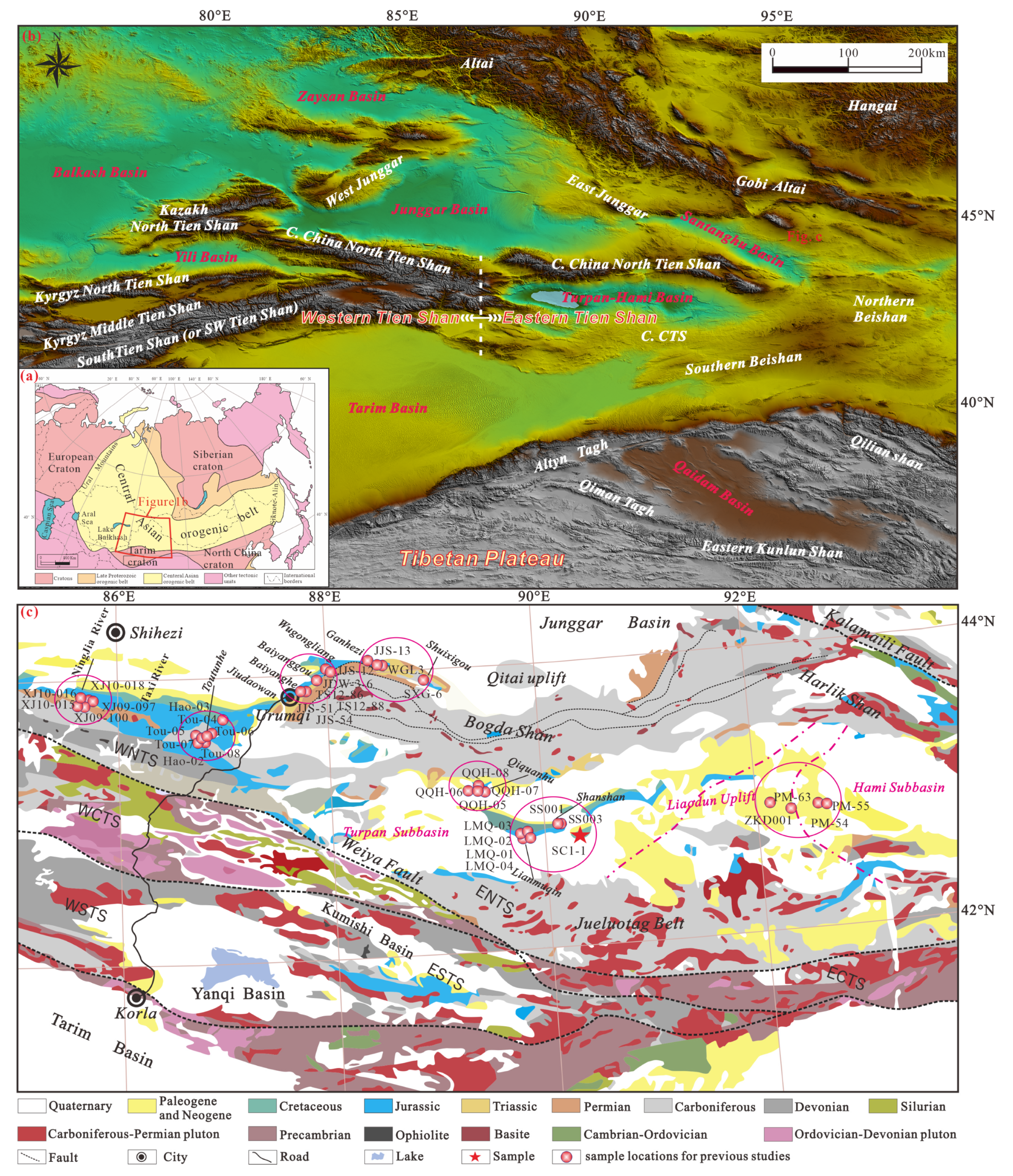
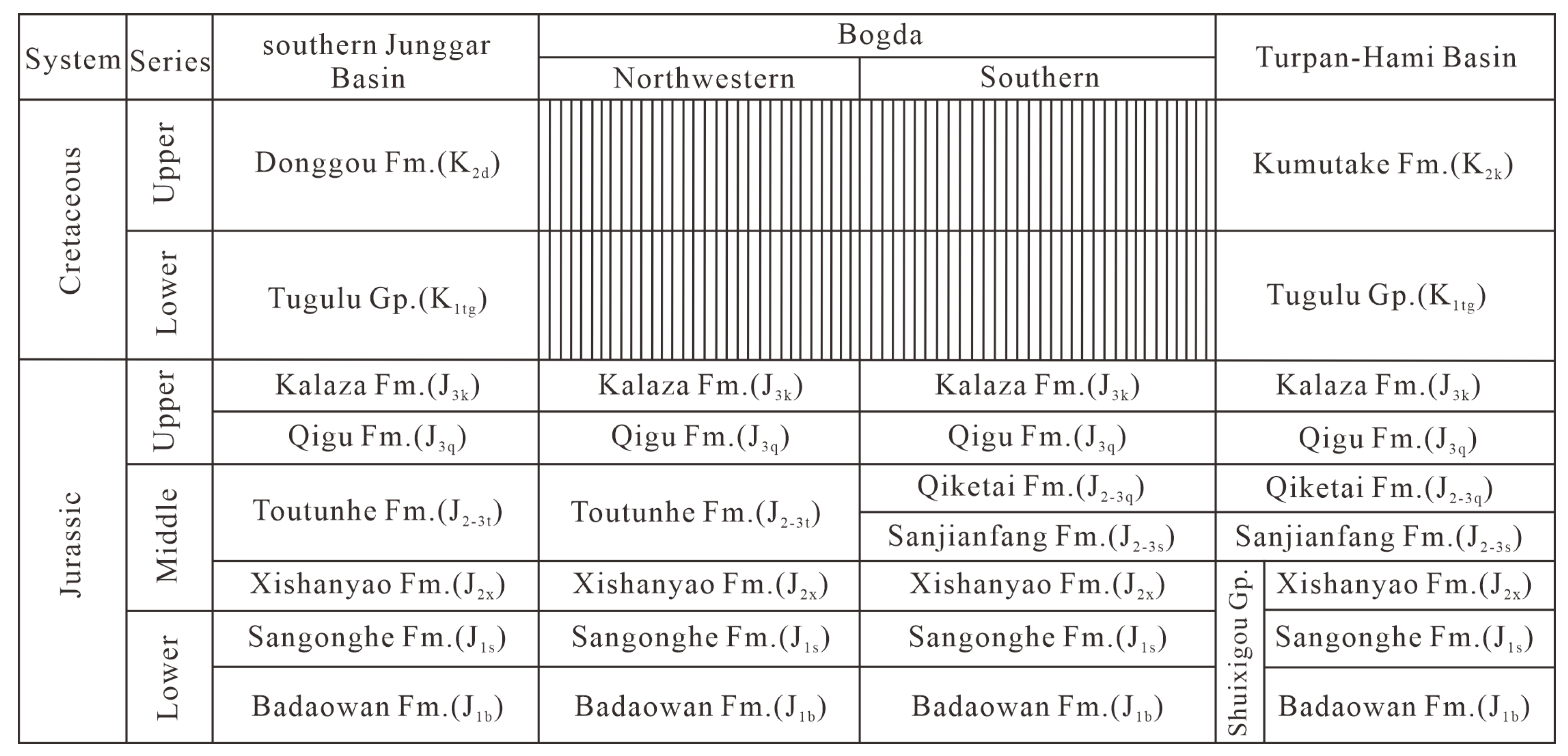

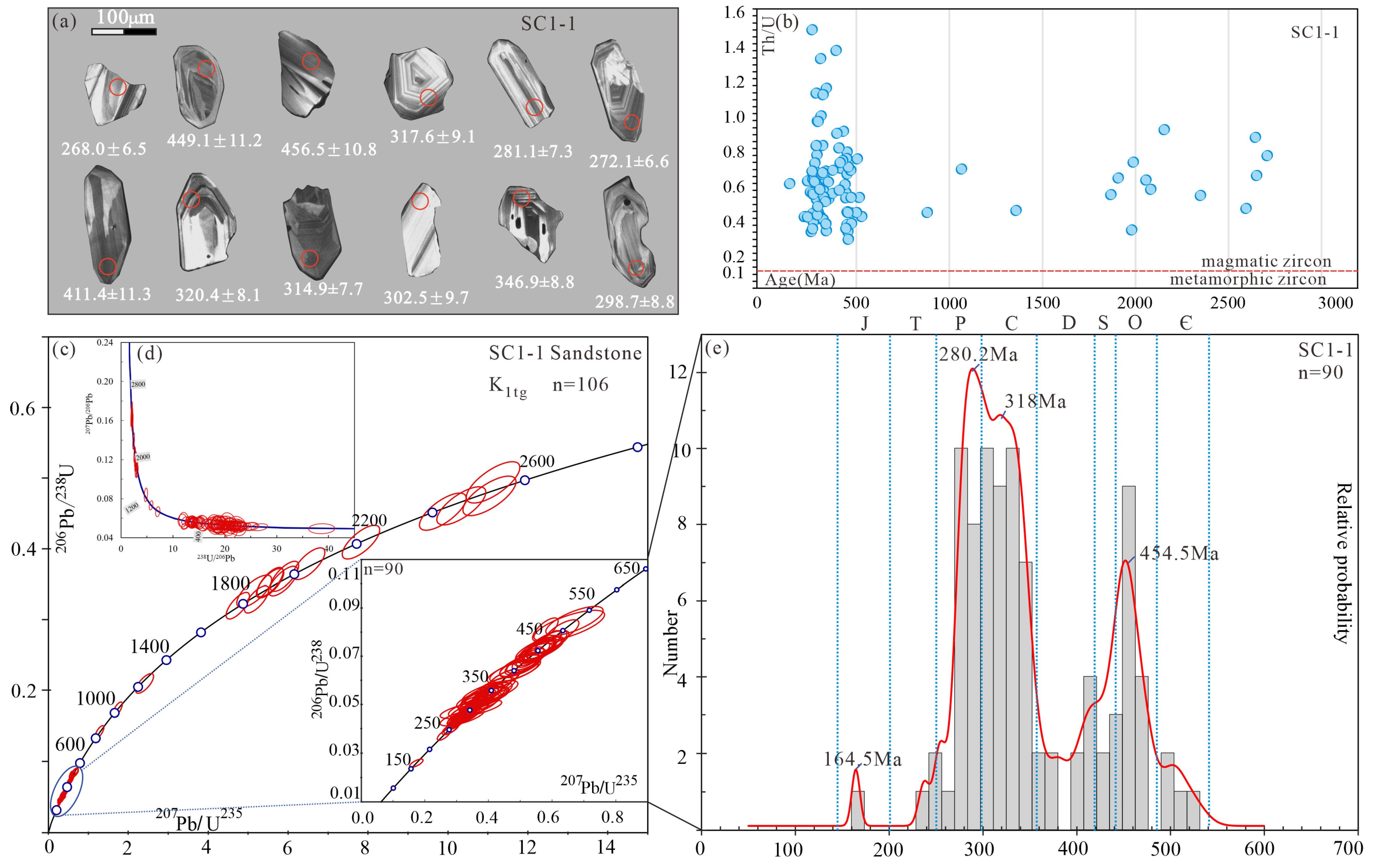
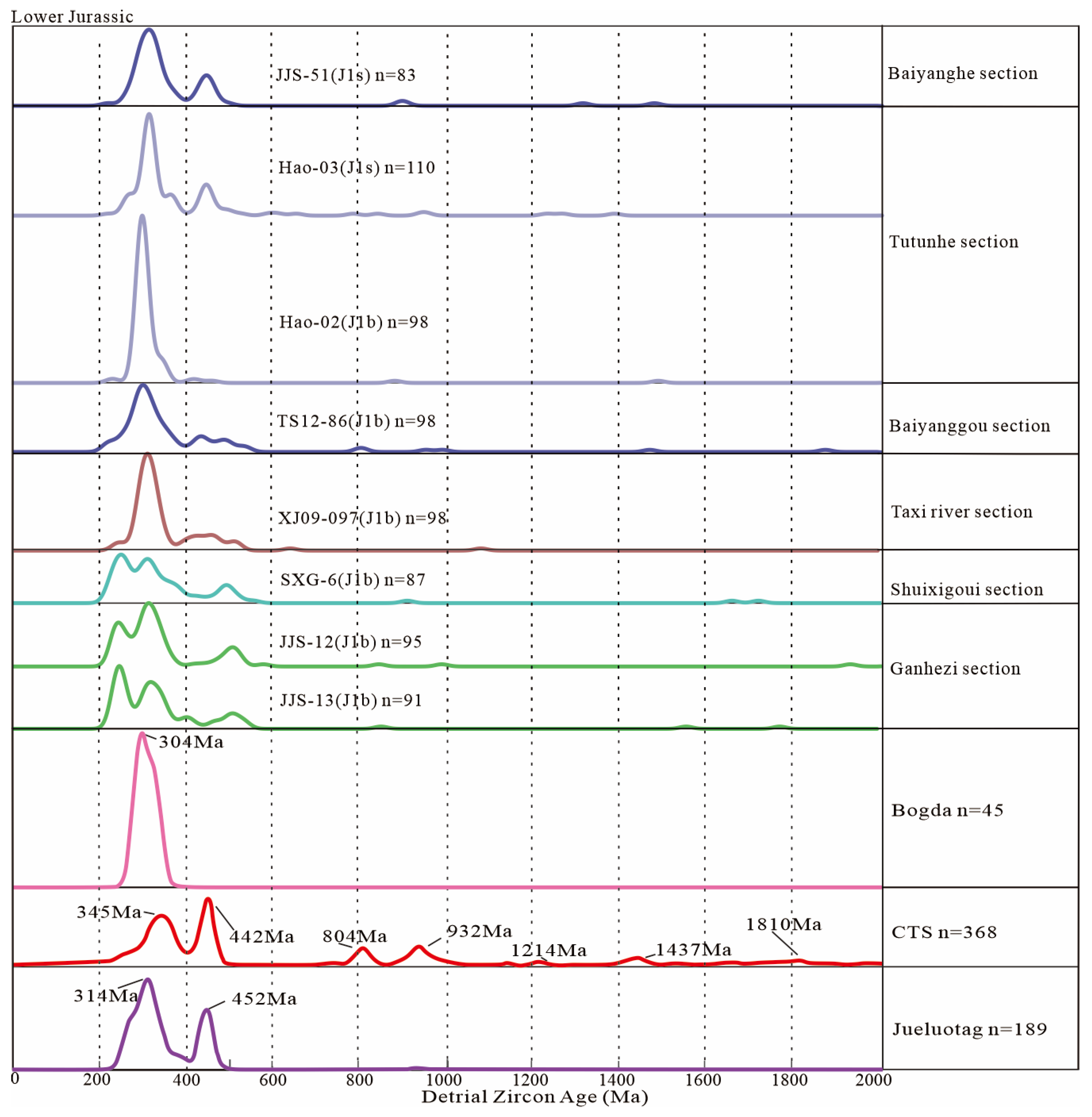

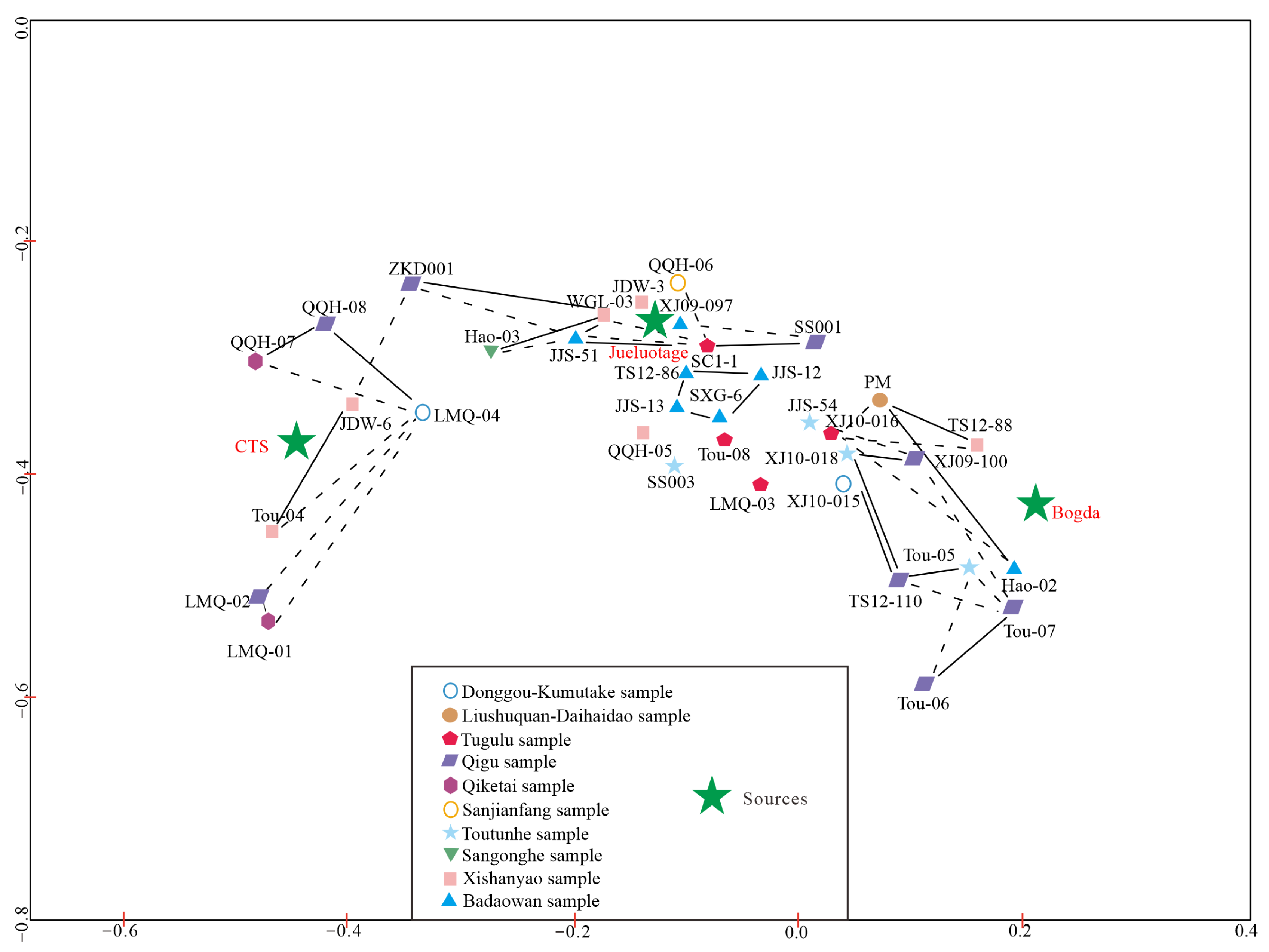
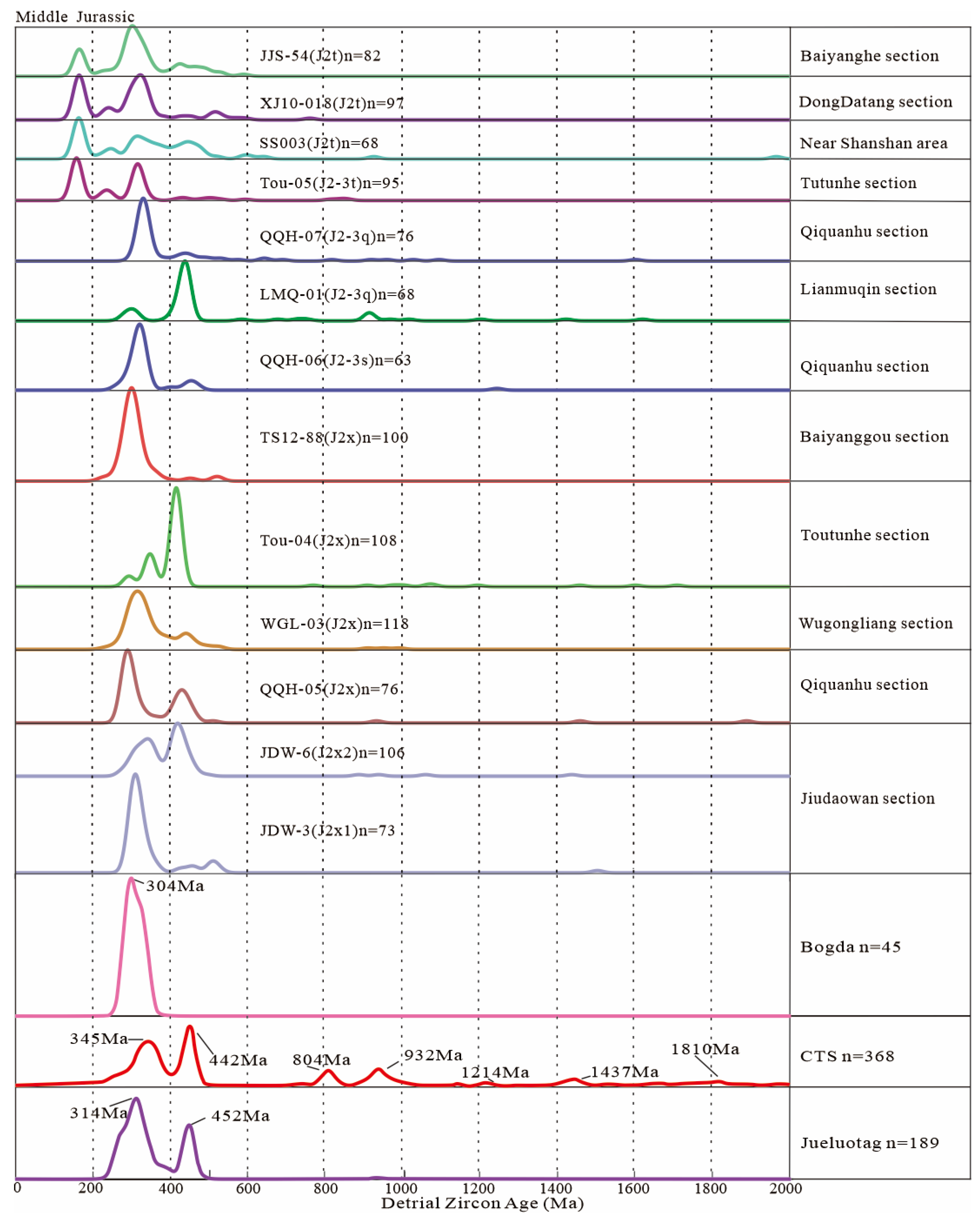

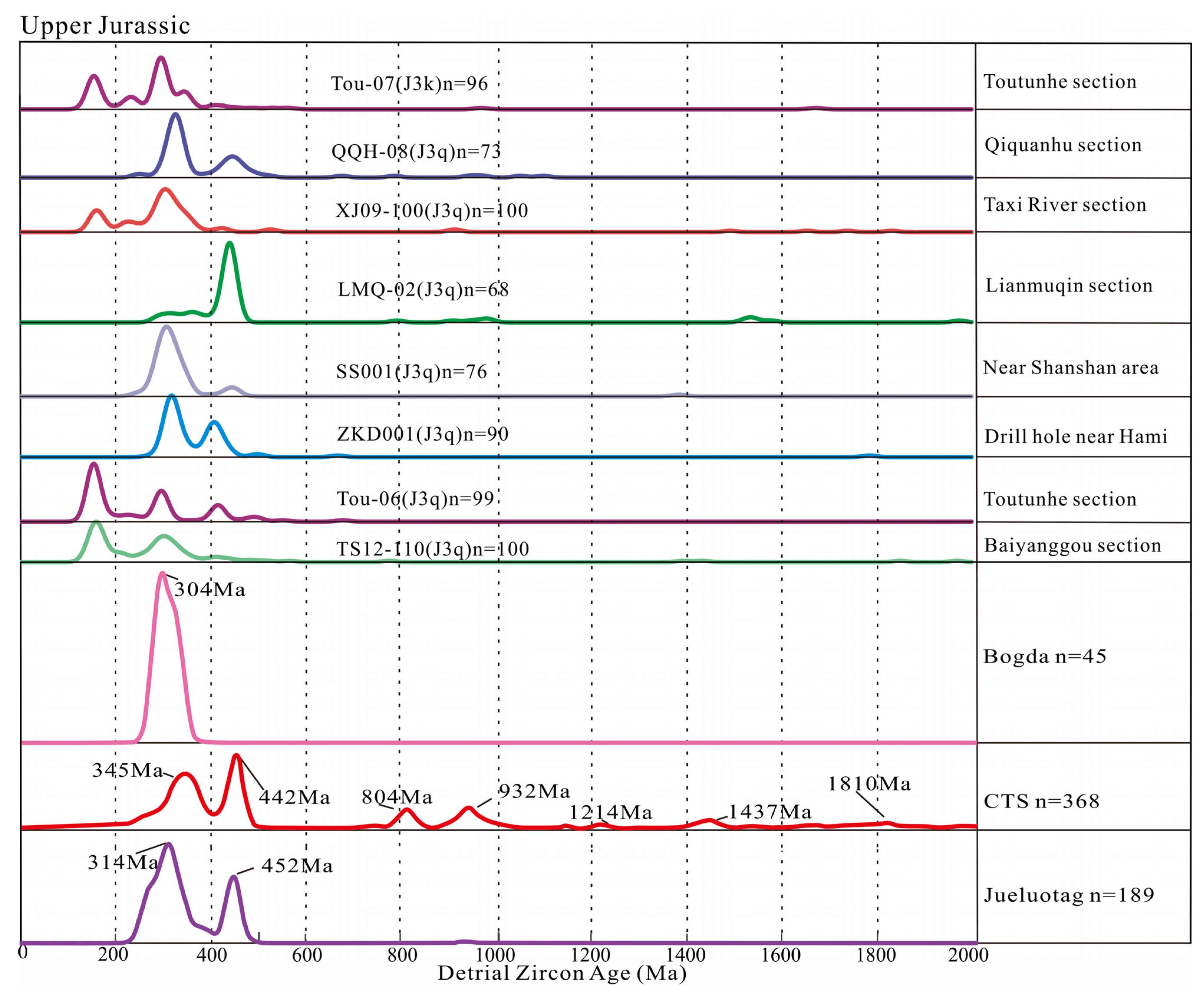

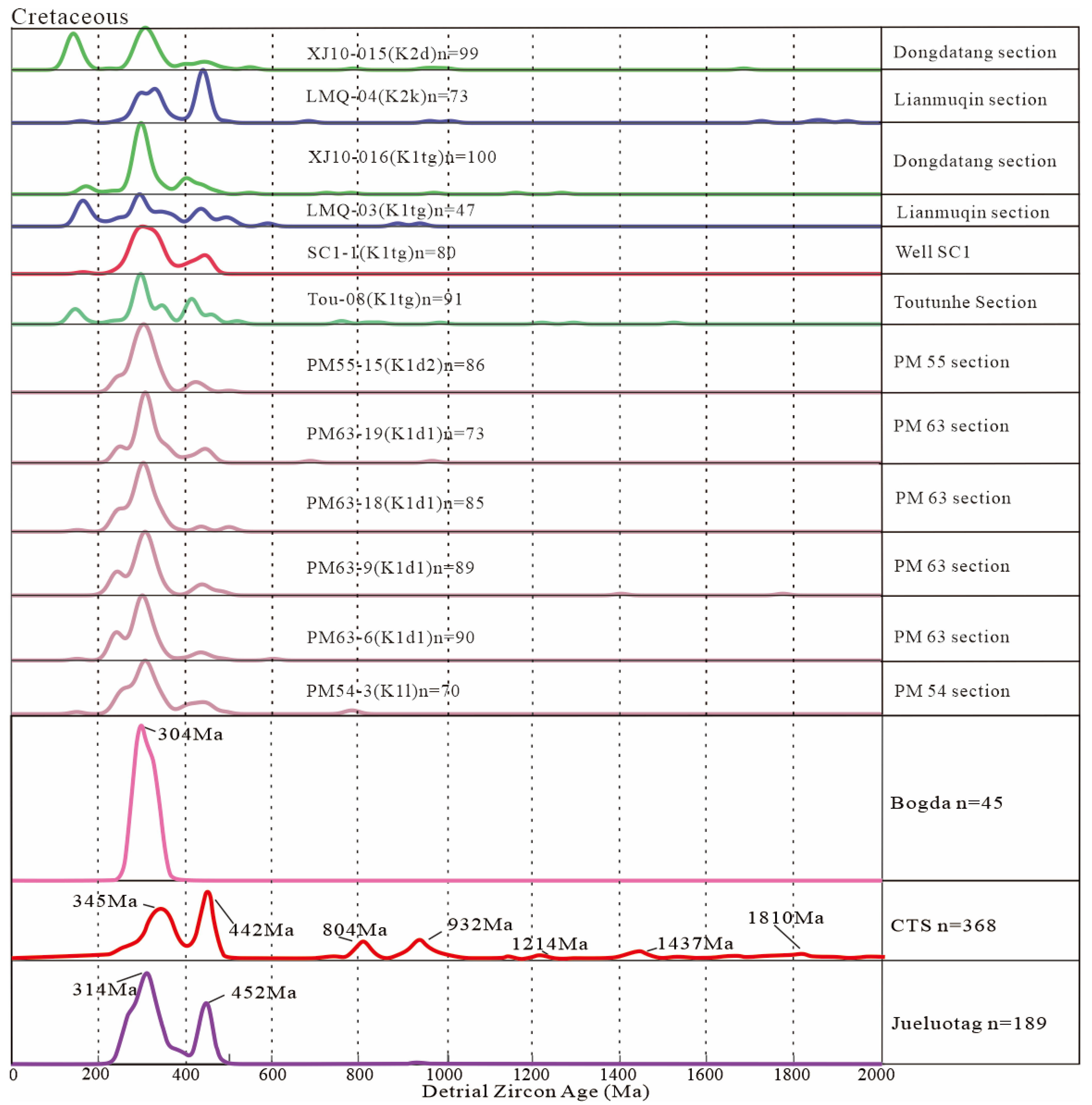

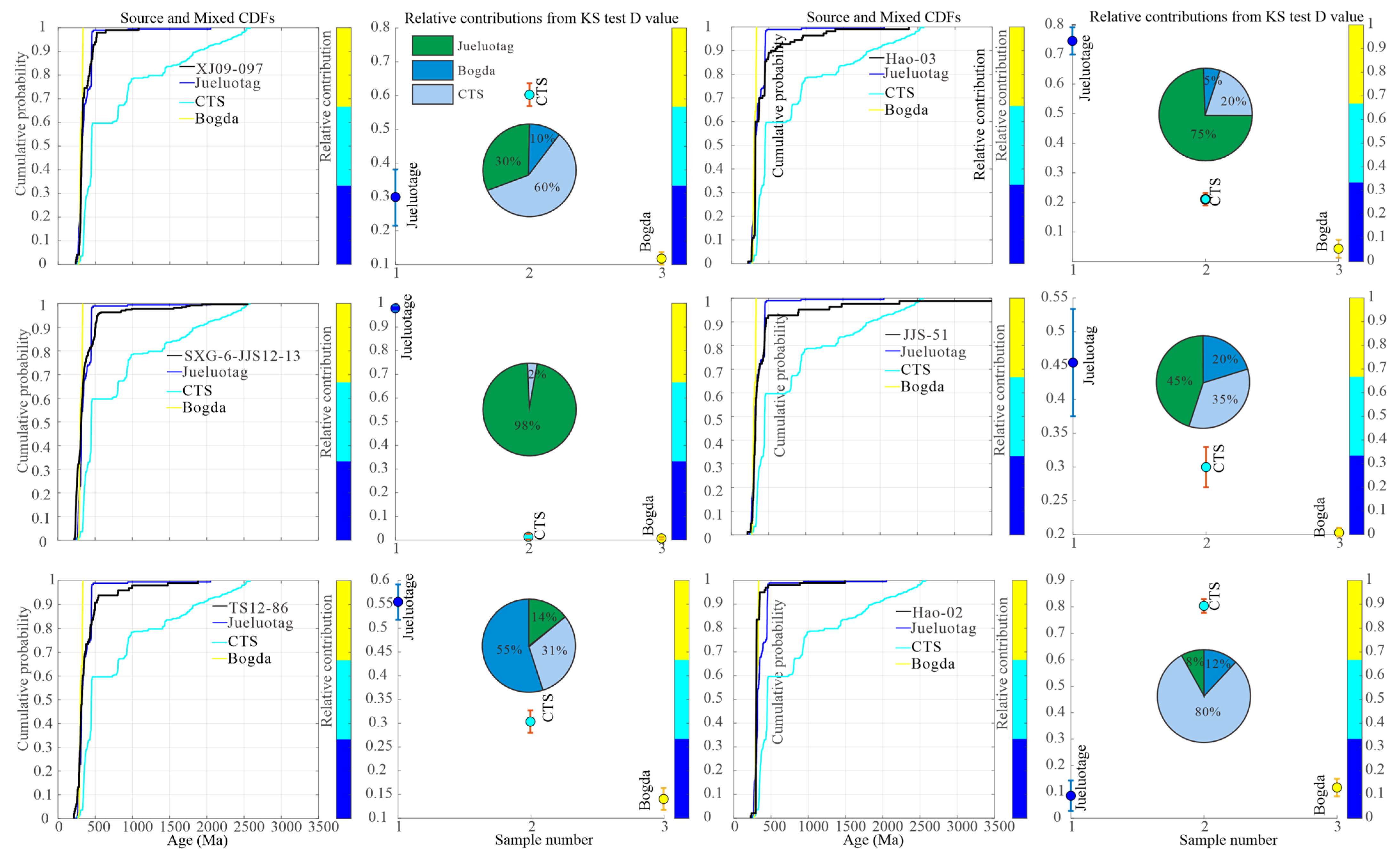


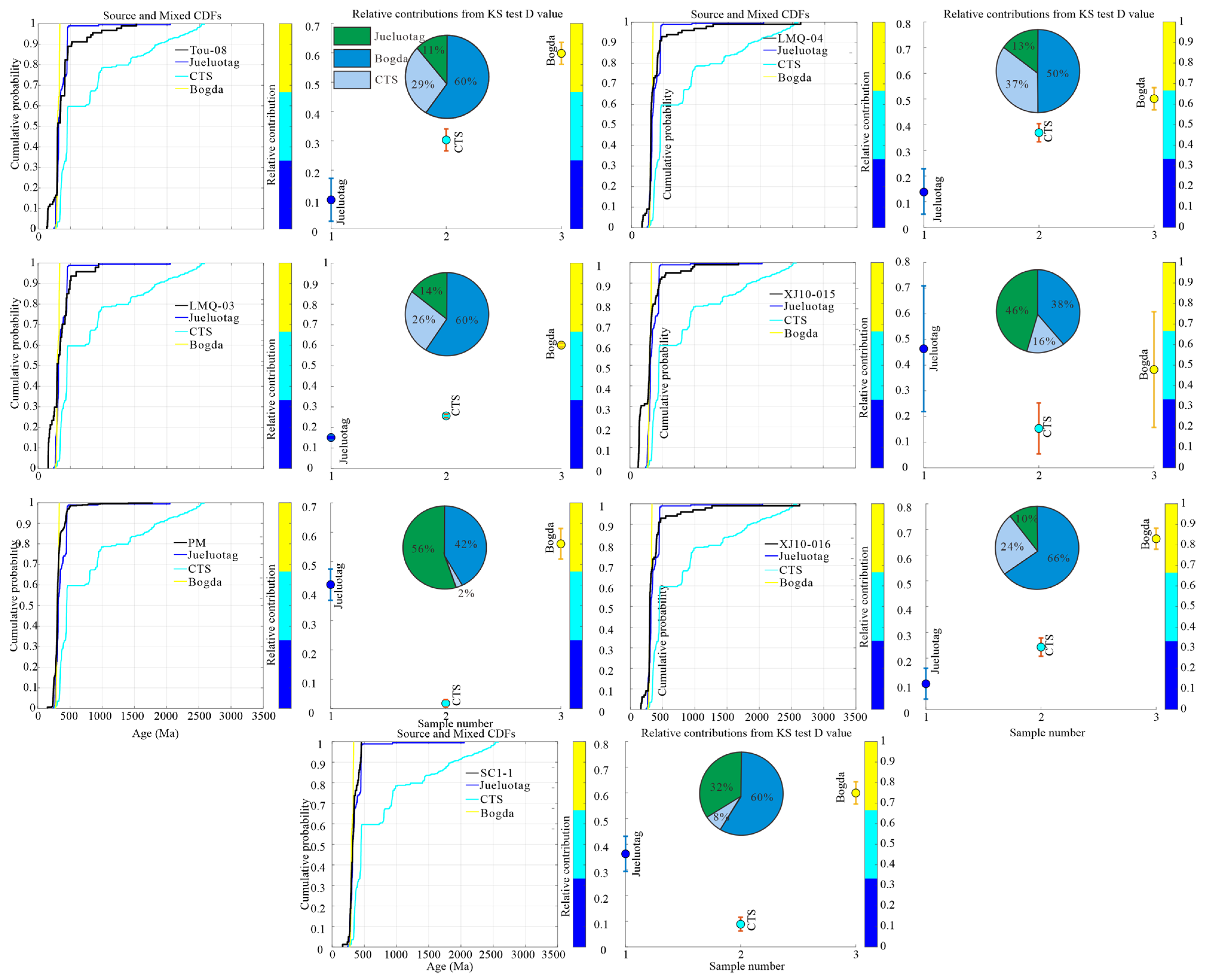

| Sample | Stratigraphic Unit | Formation | Latitude (N) | Longitude (W) | Type | Reference |
|---|---|---|---|---|---|---|
| LMQ-04 | K2k | Kumutake | 42°50′23.41″ | 89°52′37.14″ | Outcrop | [24] |
| XJ10-015 | K2d | Donggou | / | / | Outcrop | [63] |
| PM55-15 | K1d2 | Daihaidao | 42°43′34.29″ | 92°30′39.24″ | Outcrop | [43] |
| PM63-19 | K1d1 | Daihaidao | 42°44′02.75″ | 92°35′49.65″ | Outcrop | [43] |
| PM63-18 | K1d1 | Daihaidao | 42°44′02.75″ | 92°35′49.65″ | Outcrop | [43] |
| PM63-9 | K1d1 | Daihaidao | 42°44′02.75″ | 92°35′49.65″ | Outcrop | [43] |
| PM63-6 | K1d1 | Daihaidao | 42°44′02.75″ | 92°35′49.65″ | Outcrop | [43] |
| PM54-3 | K1l | Liushuquan | 42°43′34.29″ | 92°30′39.24″ | Outcrop | [43] |
| XJ10-016 | K1tg | Tugulu | / | / | Outcrop | [63] |
| SC1-1 | K1tg | Tugulu | 42°52′56″ | 90°32′7″ | Drill hole | This study |
| Tou-08 | K1tg | Tugulu | 43°47′51.12″ | 87°16′39.9″ | Outcrop | [24] |
| LMQ-03 | K1tg | Tugulu | 42°49′56.63″ | 89°52′06.60″ | Outcrop | [24] |
| Tou-07 | J3k | Kalaza | 43°47′0.84″ | 87°12′8.28″ | Outcrop | [23] |
| LMQ-02 | J3q | Qigu | 42°49′49.24″ | 89°51′28.20″ | Outcrop | [24] |
| QQH-08 | J3q | Qigu | 43°10′20.43″ | 89°23′58.88″ | Outcrop | [24] |
| Tou-06 | J3q | Qigu | 43°47′0.84″ | 87°15′49.38″ | Outcrop | [23] |
| XJ09-100 | J3q | Qigu | / | / | Outcrop | [63] |
| TS12-110 | J3q | Qigu | / | / | Outcrop | [35] |
| ZKD001 | J3q | Qigu | 42°40’35.05” | 92°24’03.44” | Drill hole | [43] |
| SS001 | J3q | Qigu | 42°56’56.89” | 90°32’13.97” | Drill hole | [43] |
| LMQ-01 | J2-3q | Qiketai | 42°49′46.98″ | 89°51′25.76″ | Outcrop | [24] |
| QQH-07 | J2-3q | Qiketai | 43°10′18.12″ | 89°23′52.75″ | Outcrop | [24] |
| Tou-05 | J2-3t | Toutunhe | 43°43′59.88″ | 87°13′18.84″ | Outcrop | [23] |
| XJ10-018 | J2t | Toutunhe | / | / | Outcrop | [63] |
| SS003 | J2t | Toutunhe | 42°57’45.73” | 90°32’22.31” | Outcrop | [43] |
| JJS-54 | J2t | Toutunhe | 43°58′55.52″ | 87°52′08.85″ | Outcrop | [25] |
| QQH-06 | J2–3s | Sanjianfang | 43°09′53.81″ | 89°24′17.50″ | Outcrop | [24] |
| JDW-6 | J2x | Xishanyao | 43°54′40.09″ | 87°40′38.47″ | Outcrop | [26] |
| JDW-3 | J2x | Xishanyao | 43°54′35.94″ | 87°40′38.28″ | Outcrop | [26] |
| TS12-88 | J2x | Xishanyao | / | / | Outcrop | [35] |
| Tou-04 | J2x | Xishanyao | 43°43′33.18″ | 87°16′51.00″ | Outcrop | [23] |
| WGL-03 | J2x | Xishanyao | 44°04′02″ | 88°12′11″ | Outcrop | [26] |
| QQH-05 | J2x | Xishanyao | 43°09′50.34″ | 89°23′40.56″ | Outcrop | [24] |
| Hao-03 | J1s | Sangonghe | 43°40′58.86″ | 87°12′8.28″ | Outcrop | [23] |
| JJS-51 | J1b | Badaowan | 43°57′16.62″ | 87°54′16.29″ | Outcrop | [25] |
| Hao-02 | J1b | Badaowan | 43°39′21.9″ | 87°13′2.04″ | Outcrop | [23] |
| TS12-86 | J1b | Badaowan | / | / | Outcrop | [35] |
| JJS-13 | J1b | Badaowan | 43°57′23″ | 87°56′10″ | Outcrop | [25] |
| SXG-6 | J1b | Badaowan | 43°55′51.34″ | 89°01′33.82″ | Outcrop | [25] |
| JJS-12 | J1b | Badaowan | 44°04′33.00″ | 88°24′03.74″ | Outcrop | [25] |
| XJ09-097 | J1b | Badaowan | / | / | Outcrop | [63] |
Publisher’s Note: MDPI stays neutral with regard to jurisdictional claims in published maps and institutional affiliations. |
© 2022 by the authors. Licensee MDPI, Basel, Switzerland. This article is an open access article distributed under the terms and conditions of the Creative Commons Attribution (CC BY) license (https://creativecommons.org/licenses/by/4.0/).
Share and Cite
Qin, Y.; Liu, C.; Yang, L.; Peng, H.; Jiao, X. Detrital-Zircon Geochronology of Jurassic–Cretaceous Strata in the Turpan-Hami Basin: Implication for the Late Mesozoic Tectonic Evolution of Eastern Tien Shan. Minerals 2022, 12, 926. https://doi.org/10.3390/min12080926
Qin Y, Liu C, Yang L, Peng H, Jiao X. Detrital-Zircon Geochronology of Jurassic–Cretaceous Strata in the Turpan-Hami Basin: Implication for the Late Mesozoic Tectonic Evolution of Eastern Tien Shan. Minerals. 2022; 12(8):926. https://doi.org/10.3390/min12080926
Chicago/Turabian StyleQin, Yang, Chiyang Liu, Lihua Yang, Heng Peng, and Xiaoqin Jiao. 2022. "Detrital-Zircon Geochronology of Jurassic–Cretaceous Strata in the Turpan-Hami Basin: Implication for the Late Mesozoic Tectonic Evolution of Eastern Tien Shan" Minerals 12, no. 8: 926. https://doi.org/10.3390/min12080926
APA StyleQin, Y., Liu, C., Yang, L., Peng, H., & Jiao, X. (2022). Detrital-Zircon Geochronology of Jurassic–Cretaceous Strata in the Turpan-Hami Basin: Implication for the Late Mesozoic Tectonic Evolution of Eastern Tien Shan. Minerals, 12(8), 926. https://doi.org/10.3390/min12080926






